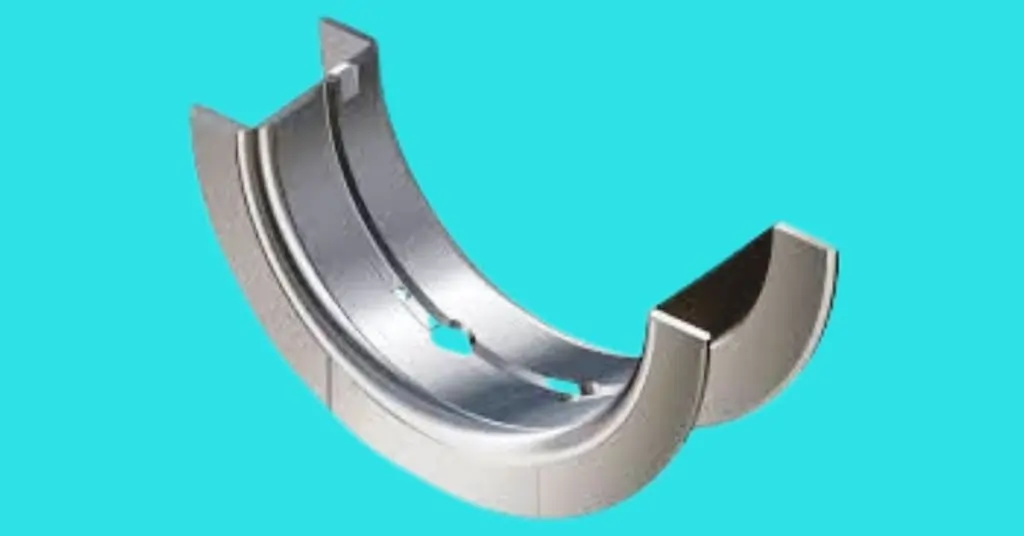Crankshaft Bearing
Is your engine not performing up to par despite regular maintenance? The secret might lie in your crankshaft bearings. These small yet vital components play a crucial role in the smooth operation of your engine, reducing friction and wear on the crankshaft and ensuring optimal performance. Without properly functioning crankshaft bearings, your engine could suffer from reduced efficiency, increased fuel consumption, and even severe damage.
In this blog post, we’ll reveal seven powerful tips to help you get the best performance from your crankshaft bearings. From choosing the right materials and ensuring precise installation to regular maintenance, proper lubrication, monitoring operating conditions, ensuring alignment and balance, and exploring upgrade options, these tips will keep your engine running smoothly and efficiently. Let’s dive in and unlock the full potential of your engine’s crankshaft bearings!
Tip 1: Choose the Right Material
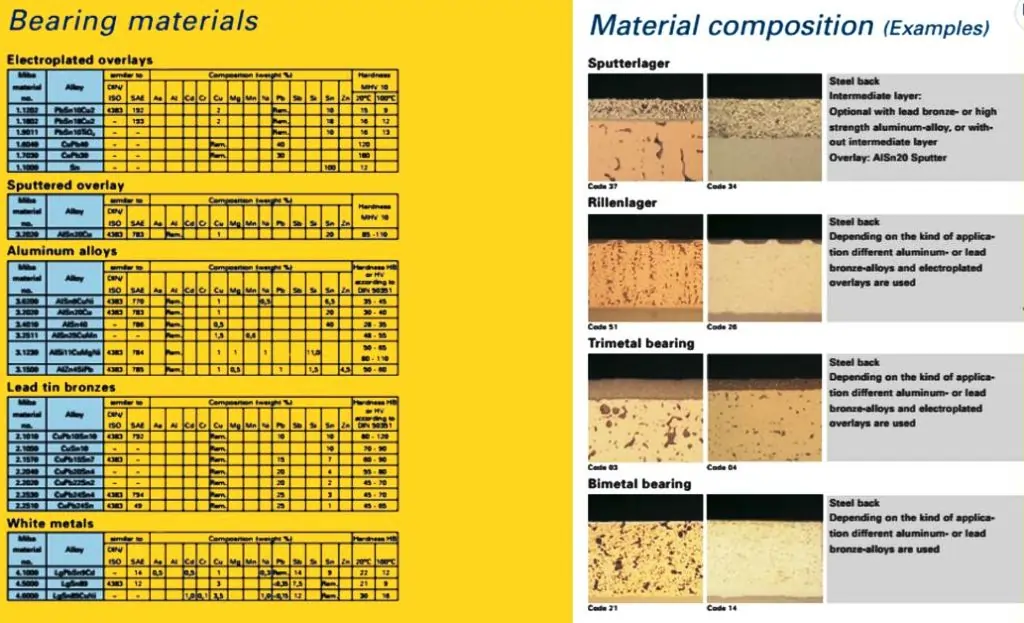
Explanation: Crankshaft bearings are made from a variety of materials, each offering unique properties suited to different engine demands. The most common materials used include aluminum, bi-metal, and tri-metal.
- Aluminum Bearings: Known for their lightweight and cost-effective nature, aluminum bearings offer good wear resistance and are often used in moderate-duty applications. They can handle a fair amount of load but may not be suitable for high-performance engines due to their lower fatigue strength.
- Bi-Metal Bearings: These bearings typically consist of an aluminum alloy layer bonded to a steel backing. They combine the benefits of aluminum with added strength from the steel, making them suitable for a wider range of applications. They provide better fatigue resistance than pure aluminum bearings but still might fall short in extreme conditions.
- Tri-Metal Bearings: Comprising a steel backing, a layer of copper or bronze, and a top layer of lead or tin, tri-metal bearings are designed for high-performance engines. They offer superior load-carrying capacity, excellent fatigue resistance, and can withstand higher temperatures. However, they are more expensive and can be overkill for standard engines.
Advantages:
- Aluminum Bearings: Pros include affordability, lightweight, and good wear resistance. Cons are lower fatigue strength and limited high-performance suitability.
- Bi-Metal Bearings: Pros include better fatigue resistance and versatility for various applications. Cons include limited extreme condition performance.
- Tri-Metal Bearings: Pros include superior load capacity, excellent fatigue resistance, and high-temperature tolerance. Cons are higher costs and potential over-specification for standard engines.
Recommendation: Selecting the right material for your crankshaft bearings depends on the specific requirements of your engine. For everyday use in moderate-duty engines, aluminum bearings offer a good balance of performance and cost. If your engine demands higher durability, especially in commercial or industrial applications, bi-metal bearings provide a robust solution. For high-performance engines, such as those found in racing or heavy-duty industrial machinery, tri-metal bearings are the best choice due to their superior strength and resistance to extreme conditions. Always consult your engine’s specifications and consider the operating environment when choosing the material for your crankshaft bearings to ensure optimal performance and longevity.
Tip 2: Precision Installation
Step 1: Marking the Engine Parts
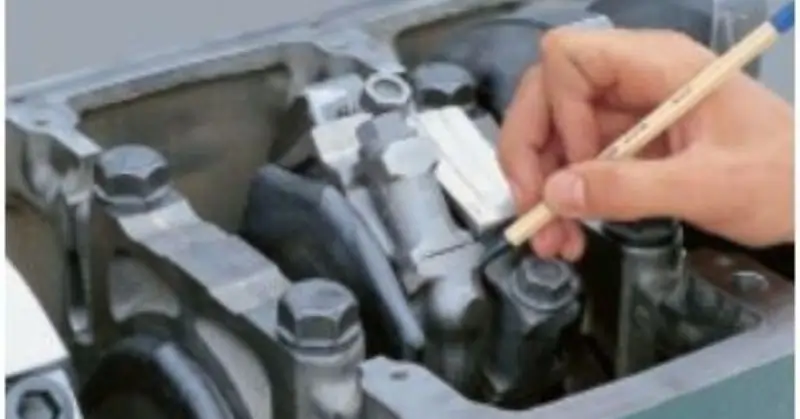
Before disassembling the engine, mark all matching parts, including connecting rods and caps, main bearing caps, and bearing shells. This ensures that each component can be reassembled in its original position, maintaining the engine’s balance and alignment.
Step 2: Cleaning the Engine Parts
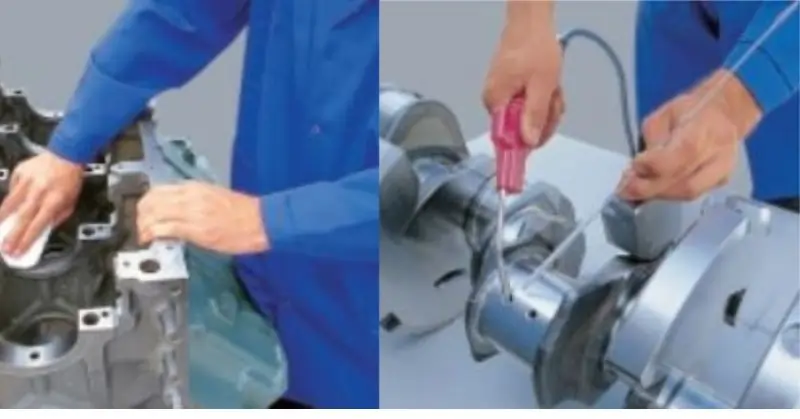
Dirt is a major cause of bearing failures, so meticulous cleaning of all engine parts is essential. When cleaning manually, use clean solvents and instruments. Pay special attention to parts within the oil circuit, such as the oil pump, screen, filter, oil pan, oil cooler, and all oil passages in the engine block and crankshaft. Any debris left behind can lead to premature bearing wear and failure.
Step 3: Checking and Repairing the Parts
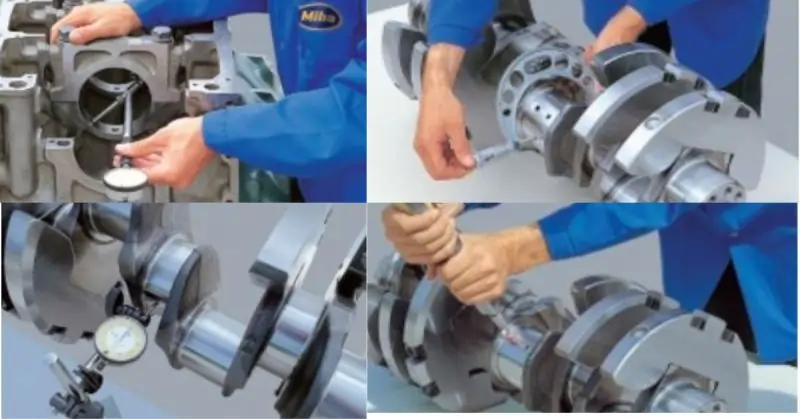
Inspect the housing bore with an ID measuring instrument to check for correct dimensions, roundness, and cylindricity. Ensure the surface is free of damage. Any deviation from specifications can cause improper bearing fit and subsequent engine damage.
Step 4: Replacement of Bearings
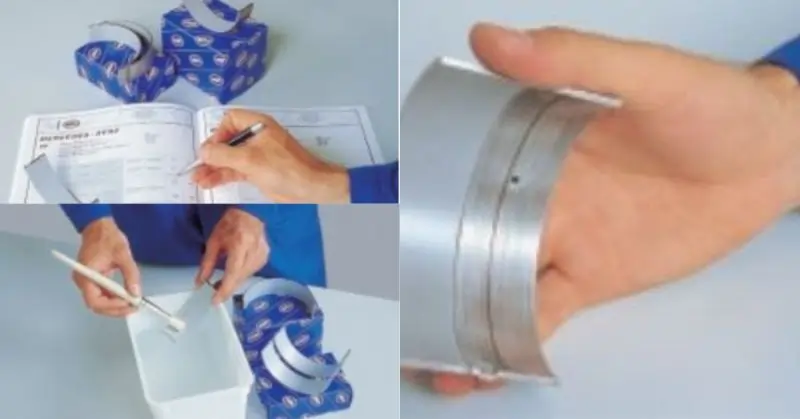
Use the Miba Engine Bearing Catalog to select the correct replacement bearings, noting available undersizes. Compare the new bearings with the old ones to ensure correct selection. Remove any protective coating from the new bearings, handling them with care to avoid damage, as they are precision parts.
Step 5: Bearing Installation
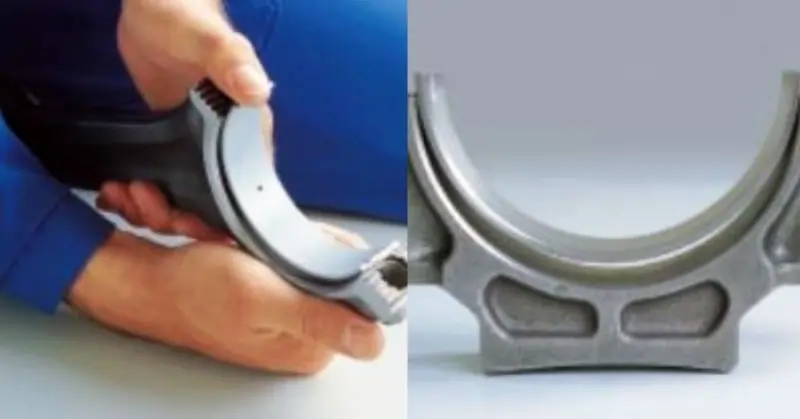
Install bearings by aligning locating lugs, pins, etc., to ensure correct positioning. The interference fit between the bearing back and housing is crucial. Ensure the bearing has an appropriate free spread to prevent it from moving or falling out during installation. Do not install bearings with no or negative free spread, as this increases the risk of shaft contact with the bearing running surface, leading to failure.
Step 6: Bearing Clearance and Its Measurement
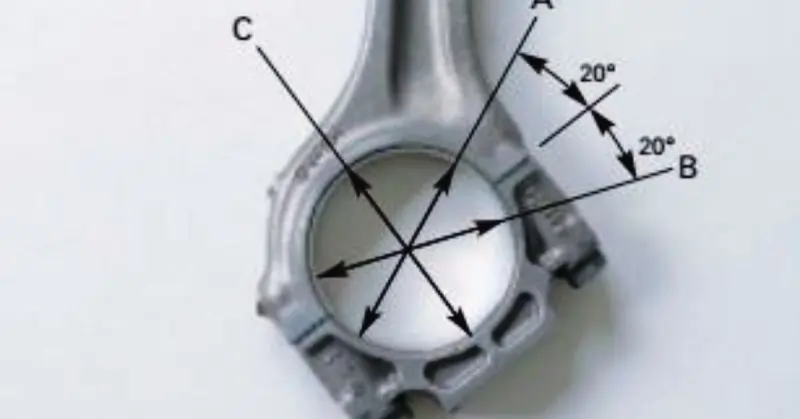
Correct bearing clearance is essential for proper bearing function. Refer to the engine’s user manual for the correct data. It is recommended to check bearing clearance after engine repair or reconditioning, ensuring proper bolt tightening before measurement. Use either a micrometer and bore gauge for precise measurement or Plastigage for a quicker, albeit less precise, method. Additionally, check for roundness and cap displacement to ensure accurate installation.
Step 7: Bolt Tightening and Inspection of Bearing Cap Preload
Follow the engine manual for the correct method and specifications for tightening cap bolts. Engine manufacturers often recommend replacing bolts during reassembly. Inspect the interference fit by measuring the gap between the cap and housing with the bolts loosened. This gap should reflect the difference between the bearing shell circumference and the bore circumference, ensuring a proper fit.
Step 8: Installation of Crankshaft
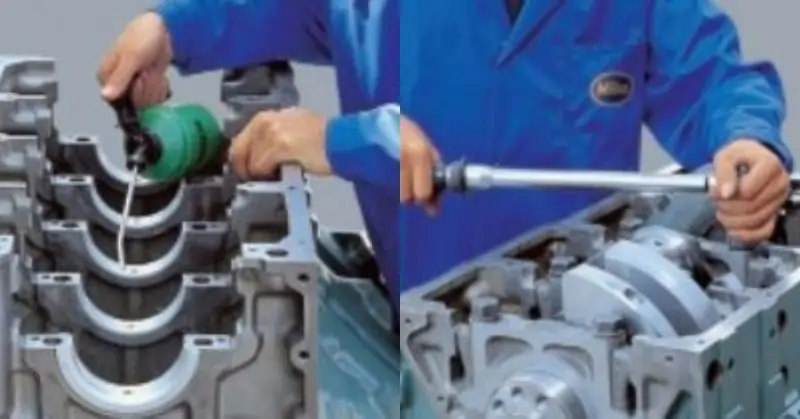
To avoid damage during dry starts, lubricate the bearing running surfaces with clean oil before inserting the crankshaft. Tighten the main bearing cap bolts to the specified torque. Ensure all parts are correctly matched and check that the crankshaft rotates smoothly and easily. Measure the crankshaft’s lateral movement using a dial gauge or feeler gauge to confirm correct axial clearance.
Tools and Techniques:
- Torque Wrench: A calibrated torque wrench is essential for tightening bolts to the exact specifications, ensuring even pressure distribution.
- Micrometer: For measuring crankshaft journal diameters and verifying they are within specified tolerances.
- Engine Assembly Lubricant: Use high-quality assembly lubricant to protect bearings during initial start-up.
- Lint-Free Cloths: For cleaning surfaces without leaving any residue or fibers.
- Cleaning Solvent: Use an appropriate solvent to remove debris, oil, and contaminants from surfaces.
Tip 3: Regular Inspection and Maintenance
Frequency: Regular inspection of crankshaft bearings is crucial for ensuring the longevity and optimal performance of your engine. It is recommended to inspect the crankshaft bearings every 500 hours of engine operation or during routine engine overhauls, whichever comes first. For high-performance or heavily used engines, more frequent inspections may be necessary.
Signs of Wear:
- Excessive Noise: Unusual knocking or ticking sounds coming from the engine can indicate worn crankshaft bearings.
- Oil Pressure Drops: A sudden decrease in oil pressure can be a sign of bearing wear, as worn bearings allow oil to escape more easily, reducing overall pressure.
- Metal Shavings in Oil: The presence of metallic particles in the engine oil can indicate bearing deterioration, as the bearings wear down and shed material.
- Vibration: Increased engine vibration or rough operation can be a symptom of worn bearings, affecting the smooth rotation of the crankshaft.
- Oil Leakage: Visible oil leaks around the crankshaft area might suggest compromised bearings that are no longer maintaining a proper seal.
Maintenance Procedures:
- Oil Analysis: Regularly analyze engine oil for contamination or the presence of metal particles. This can provide early warning signs of bearing wear and allow for preemptive maintenance.
- Visual Inspection: During engine overhauls, visually inspect the crankshaft bearings for signs of wear, scoring, or discoloration. Replace any bearings that show significant wear or damage.
- Measure Clearances: Use a micrometer and bore gauge to measure the clearance between the crankshaft and bearings. Compare these measurements to the engine’s specifications to ensure they are within acceptable limits. Excessive clearance can lead to improper lubrication and increased wear.
- Proper Lubrication: Ensure the engine uses high-quality, clean oil and that the oiling system is functioning correctly. Proper lubrication reduces friction and wear on the crankshaft bearings.
- Cooling System Maintenance: Maintain the engine’s cooling system to prevent overheating, which can accelerate bearing wear. Ensure coolant levels are adequate and that the cooling system is free of leaks or blockages.
- Alignment and Balancing: Periodically check the alignment and balance of the crankshaft. Misalignment can cause uneven bearing wear and reduce the lifespan of the bearings.
- Bolt Tightening: Ensure that all bearing cap bolts are tightened to the manufacturer’s specifications. Proper torque ensures even pressure distribution and reduces the risk of bearing failure.
- Engine Load Management: Avoid overloading the engine, as excessive loads can increase stress on the bearings. Follow the manufacturer’s guidelines for maximum load capacities and operating conditions.
- Use of Additives: Consider using oil additives designed to enhance lubrication and reduce wear on crankshaft bearings. These additives can provide an additional layer of protection, particularly in high-stress environments.
- Documentation and Records: Keep detailed records of all inspections, maintenance procedures, and any replacements. This history can help identify patterns of wear and inform future maintenance schedules.
Tip 4: Monitor Operating Conditions
Temperature and Pressure: Crankshaft bearing performance is heavily influenced by operating conditions, particularly temperature and pressure. Excessive heat can degrade lubricants, causing them to lose viscosity and leading to increased metal-to-metal contact and wear. High temperatures can also cause thermal expansion, affecting bearing clearances and leading to potential seizure or excessive clearance issues.
Pressure, specifically oil pressure, is crucial for maintaining a consistent oil film between the bearing and crankshaft. Low oil pressure can result in inadequate lubrication, leading to increased friction, wear, and potential bearing failure. Conversely, excessively high oil pressure can cause oil to bypass the bearings, reducing lubrication efficiency and potentially leading to overheating and wear.
Monitoring Tools:
- Temperature Sensors: Install high-precision temperature sensors on the engine block and near the crankshaft bearings to continuously monitor operating temperatures. These sensors can alert operators to overheating conditions before damage occurs.
- Oil Pressure Gauges: Use reliable oil pressure gauges to monitor the engine’s oil pressure in real-time. Digital gauges with alarm settings can notify operators of pressure drops or spikes, allowing for immediate corrective action.
- Thermographic Cameras: Employ thermographic cameras for periodic inspections. These cameras can detect hotspots and uneven temperature distributions, indicating potential issues with bearing lubrication or alignment.
- Vibration Analysis Tools: Vibration analysis tools can detect changes in engine vibration patterns, which can be an early indicator of bearing wear or misalignment. Regular vibration monitoring helps in diagnosing and addressing issues before they escalate.
- Data Loggers: Integrate data loggers that record temperature and pressure readings over time. Analyzing this data helps in identifying trends and patterns that could indicate developing problems.
Adjustments:
- Optimize Cooling Systems: Ensure that the engine’s cooling system is functioning efficiently. Regularly inspect and maintain radiators, coolants, and water pumps. Upgrading to a more efficient cooling system can help manage engine temperatures better.
- Adjust Lubricant Viscosity: Depending on the operating temperature and pressure conditions, selecting a lubricant with appropriate viscosity can improve bearing performance. High-temperature environments may require higher viscosity oils to maintain a proper lubricating film.
- Maintain Proper Oil Levels: Regularly check and maintain the correct oil levels in the engine. Insufficient oil can lead to low pressure, while overfilling can cause high pressure, both detrimental to bearing performance.
- Pressure Relief Valves: Install pressure relief valves to maintain optimal oil pressure within the engine. These valves help prevent pressure spikes that could bypass bearings and reduce lubrication efficiency.
- Operational Adjustments: Adjust engine load and operating speeds according to the manufacturer’s guidelines. Avoid prolonged high-load or high-speed operations that can elevate temperatures and pressure beyond safe limits.
- Environmental Controls: If operating in extreme environmental conditions, such as high ambient temperatures, consider additional cooling solutions or protective measures to shield the engine from excessive heat.
Tip 5: Alignment and Balancing
Importance: Proper alignment and balancing are critical for crankshaft bearing performance. Misalignment can cause uneven load distribution across the bearings, leading to accelerated wear, increased friction, and potential bearing failure. Similarly, an unbalanced crankshaft can introduce vibrations and additional stresses, compromising the engine’s overall stability and longevity. Ensuring precise alignment and balance minimizes these risks, promotes smooth engine operation, and extends the lifespan of crankshaft bearings.
Techniques:
- Alignment Techniques:
- Visual Inspection: Begin with a visual inspection of the crankshaft and engine components. Look for signs of wear, misalignment, or damage. Check for proper seating of the crankshaft in the bearings and ensure that all components are correctly positioned.
- Measuring Tools: Use precise measuring tools such as dial indicators, micrometers, and alignment bars. These tools help in accurately measuring the alignment of the crankshaft and detecting any deviations.
- Feeler Gauges: Use feeler gauges to measure the gap between the crankshaft and the bearings. This ensures that the crankshaft is seated properly and there is no excessive clearance that could lead to misalignment.
- Laser Alignment: Employ laser alignment tools for high-precision alignment. These tools provide accurate measurements and help in adjusting the crankshaft to achieve perfect alignment with minimal effort.
- Balancing Techniques:
- Static Balancing: Perform static balancing by placing the crankshaft on a set of knife edges and allowing it to rotate freely. The crankshaft should remain stationary at any position. If it rotates to a specific point, it indicates an imbalance. Adjust by adding or removing weight to achieve balance.
- Dynamic Balancing: Utilize dynamic balancing machines that spin the crankshaft at operating speeds. These machines detect imbalances and provide precise data on where to add or remove weight. This technique is more accurate and suitable for high-performance engines.
- Counterweights Adjustment: Ensure that counterweights on the crankshaft are correctly positioned and adjusted. Properly balanced counterweights help in reducing vibrations and maintaining smooth engine operation.
- Weight Matching: Match the weights of pistons, connecting rods, and other rotating components to ensure uniform distribution of mass. This prevents imbalances and promotes smooth crankshaft rotation.
Professional Help:
- Complex Engines: For high-performance, heavy-duty, or complex engines, professional assistance is often necessary. Professionals have the expertise and specialized equipment to achieve precise alignment and balancing.
- Severe Misalignment or Imbalance: If visual inspections or basic techniques indicate severe misalignment or imbalance, seek professional help. Attempting to correct significant issues without the proper tools and experience can lead to further damage.
- Regular Maintenance: Incorporating professional alignment and balancing into regular maintenance schedules ensures optimal engine performance. Professionals can detect and address issues that may not be apparent during routine inspections.
- Rebuilds and Overhauls: During engine rebuilds or overhauls, professional alignment and balancing are crucial. This ensures that the engine components are correctly reassembled, reducing the risk of future bearing issues.
- Diagnostic Services: Utilize professional diagnostic services to monitor and assess the alignment and balance of the crankshaft regularly. Advanced diagnostic tools can provide detailed reports and recommendations for maintaining optimal performance.
FAQ on “Crankshaft Bearing”
Q: How often should I inspect my crankshaft bearings?
A: Every 500 hours or during overhauls.
Q: What are signs of worn crankshaft bearings?
A: Noise, low oil pressure, and metal shavings in oil.
Q: Which lubricant is best for crankshaft bearings?
A: Synthetic oils.
Q: Why is proper alignment and balancing important for crankshaft bearings?
A: It ensures even load distribution and reduces vibrations.
Conclusion
Achieving optimal performance and longevity for your crankshaft bearings involves a combination of choosing the right materials, precise installation, regular inspection and maintenance, proper lubrication, monitoring operating conditions, and ensuring perfect alignment and balancing. By following these advanced tips, you can prevent premature wear and avoid costly repairs. Remember, the health of your crankshaft bearings is integral to your engine’s overall efficiency and reliability. Implement these strategies diligently, and your engine will run smoothly for years to come.
